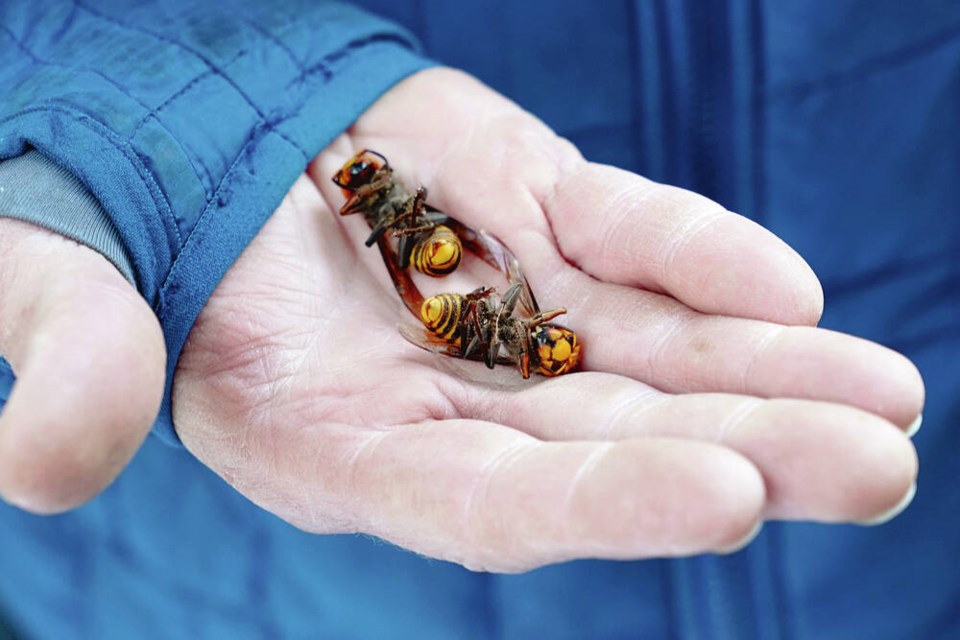Flowers are blooming, birds are raising their young, and bees are doing their thing.
And if bees are out and about, so are wasps.
That means if any northern giant hornets survived here in B.C. last year, they, too, are out searching for food.
Officials reported late last year, after months-long, co-ordinated cross-border surveillance and trapping, that no more of the hornets had been found in B.C. or Washington.
It’s great news for honeybees, farmers, gardeners and fruit growers in the region.
But the findings are not definitive. Absence of evidence isn’t evidence of absence. Just because no more hornets were found doesn’t mean some didn’t manage to avoid detection.
Nor does it mean another hornet queen capable of starting a viable colony hasn’t found its way to our shores. If the hornet arrived here once, it can do so again.
That’s the thing with invasive species — an introduction that occurs once can repeat. After all, the avenues by which northern giant hornets first came to our west coast still exist.
The insect, native to eastern Asia, was found for the first time in North America in 2019, in Nanaimo. Over ensuing months, other hornets and nests were found in the Lower Mainland and northern Washington state.
Trapping programs kicked in on both sides of the border. Nobody wanted the insect to become established here.
The hornet is known to co-ordinate gang attacks on beehives, destroying entire colonies within a few hours. The hornets’ target is the bee larvae buffet hidden in the hive’s honeycomb. The hornets seek the soft, squidgy, protein-rich bee grubs to feed to their own young.
They do the same to other social insects, such as wasps, ants, other bee species, as well as beetles. That’s also a problem here in North America, but it’s one that is less defined than the threat to honeybees.
According to Stats Canada’s 2021 Overview of the 91原创 Honey and Bee Industry, honeybees provide an estimated $7 billion worth of pollinating services to Canada’s agriculture industry every year. They also produce an additional $280 million in honey products annually.
Honeybee health is already suffering sufficient stresses with mites, disease, pesticides and climate change without the threat of hive-decimating hornets. So, despite the fact no more hornets were found in the region last summer and fall, surveillance and trapping continue, and research into the critter carries on.
Scientists think the hornets hitched a ride to our shores on goods shipped from Asia. Sea ports are common entry points to new territories for invasive insects, plants and microorganisms.
Officials with the 91原创 Food Inspection Agency, the main federal agency responsible for preventing, containing and managing invasive species in Canada, are stationed at major ports and railway depots, where they conduct random inspections of incoming shipping containers and their contents.
However, they can’t inspect everything. As people who live along the coast from Sooke to Campbell River know, thousands of ships enter the Port of 91原创 each year. Each ship can carry thousands of containers. And each container can hold thousands of items, all packed tightly.
One estimate suggests that just two per cent of shipments are searched for evidence of harmful organisms.
Things get through.
It’s also possible that hornets were smuggled in. The hornets are eaten throughout Asia in food and used in traditional medicine. It wouldn’t be the first time a critter was packaged up and posted across the ocean. If a cat can survive being mailed in a package from China to Richmond, as happened recently, a hornet should have no problem.
Trade and mail across the 91原创 Ocean aren’t going to stop. Not even in the first fearful months of the pandemic, when supply chains gummed up and the number of ships anchoring in the straits dwindled, did international trade and mail stop.
They’re not going to stop now.
And that means, even if nobody has seen a live giant hornet on this side of the 91原创 in a year, the risk of more hornets arriving on our shores at any time remains. And the need for vigilance persists.
>>> To comment on this article, write a letter to the editor: [email protected]



